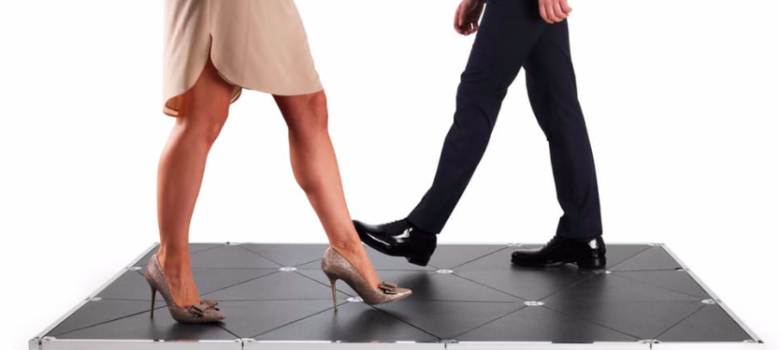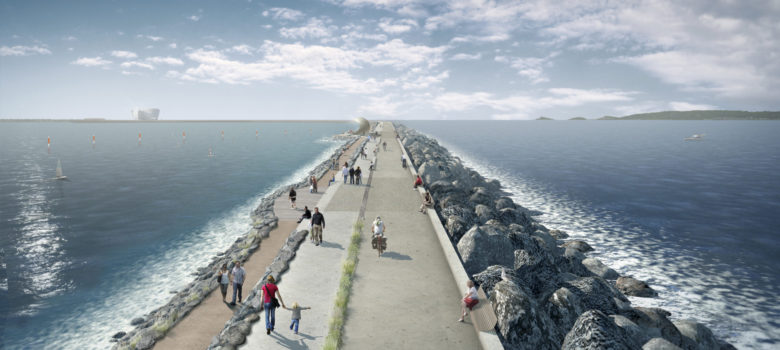
On Wednesday I watched Pavegen’s Apple-style online live stream launch of their new product. It’s a London company which makes smart flooring that harnesses kinetic energy from footsteps. The company offers customisable surfaces to be used in high-volume public spaces, such as shopping centres, concert venues and sports grounds.
It’s clear that – seven years after the idea was thought up – a lot of funding is now pouring in. The brand and technology have both been developed and the company has come a long way since winning at the Ethical Awards in 2011. It now has offices in several countries. But can the product really live up to the hype? Is it worth more than just novelty factor?
How does the technology work?
Pavegen’s tiles are electro-magnetic. The top surface is made partly from recycled materials (rubber from old truck tyres). Put very simply, the tiles have flywheels beneath them that spin when walked on, producing up to 7W with every footstep. The triangular shape means all of the tile can generate energy, as the corners flex, unlike the previous square design. There are generators in each corner. The company claims the tiles are easy to pack, ship and install. The electricity can be used to power appliances directly, or stored for later use.
How do Pavegen tiles compare to other renewable technologies?
Per square metre, there’s far more floor space in cities than space on roofs for solar panels. This is where I can see the logic. The floor tiles are also not dependent on weather conditions, unlike solar and wind power. They are rainproof, working underwater at a depth of 1.5m. However, each tile can only generate tiny amounts of energy compared to other renewables.
What is next for Pavegen?
They want the tiles to be global and affordable. Pavegen’s CEO Laurence Kemball-Cook says he wants to sell it at a price ‘as near as possible’ to normal flooring tiles’. At a current price of £600 per square meter, this is clearly not going to happen any time soon.
The current main focus is using Pavegen to directly power lights. There are already some tiles installed at Heathrow and they will soon be at Westfield Stratford powering the entrance lighting. They will also power some street lights in Washington DC. They will be popping up in several cities, although covering small areas. The idea will presumably be rolled out on a grander scale if successful.

Will people care enough to cooperate and will companies adopt the payback scheme? It’s hard to think it would be worth their while unless there are large amounts of electricity generated, which the technology is not yet capable of.
Final thoughts
At its current rate of conversion, it sadly seems like a bit of a gimmick. However, it is definitely something worth keeping an eye on. It’s an interesting idea for energy harnessing that has no adverse effects on the planet, other than the CO2 emitted during manufacture. Although at the moment the tiles do not produce a significant enough amount of energy to meet the demands of modern life, if they were adopted on a wide scale the technology might become more viable.
Think we missed something? Do you have a different opinion?
Comment below to get your voice heard…













I believe that ‘rubber from old truck tyres’ is toxic – see http://www.ehhi.org/reports/turf/health_effects.shtml#f.
From this web page, which appears authoritative:
SUMMARY OF TOXIC ACTIONS
In summary, the toxic actions of concern from the materials that were released from recycled crumb rubber include:
◾Severe irritation of the respiratory system
◾Severe irritation of the eyes, skin and mucous membranes
◾Systemic effects on the liver and kidneys
◾Neurotoxic responses
◾Allergic reactions
◾Cancers
◾Developmental effects
Perhaps another material needs to be found!
Hi there,
You need to get the tech right…I would guess that the generation is not piezoelectric but electromagnetic induction via a spinning magnet and static coils. If one had static magnets and a spinning coil then one has excessive difficulty in tapping off the electricity….need sliprings or commutator…not good.
So possibly similar to a dynamo with vertical downward force spinning a magnet…so mgh gives the energy per footfall where m = kg weight of walker, g = 9.8 m/sec squared and h = 5mm, the tile displacement.
So circa 3.5 watts/footfall on potential energy or say 5-7 watts with a bit of “jump” energy…
Pavegen have done well to extract 5-7 watts per footfall…good efficiency…
Well I made the same calculation for a 75kg weighing individual, of course Watt is not energy, Ws would be. So the potential energy converted with a 5mm sink-in is 3.6J I doubt a 100% energy retrieval though. Something like a spring or other component has to bring back the surface to the initial level for the next step and some energy would go into this mechanism as well. And extracting usable energy of the remaining energy is also not feasible. Best case is IMHO 70-80%. So I guess you will get max 50% of the above 3.6Ws of electrical energy usable for LEDs and electronics . My biggest concern though: How many footstep does the mechanism last?
It’s really awesome, generating power just by walking on it, People should start using these kind of things so that we can generate much amount of energy and these tiles should be placed in the busy areas so that more power is generated. What a novel idea
What if you invented a trampoline using the same idea, it would be super awesome!